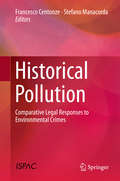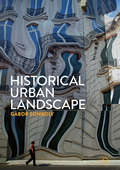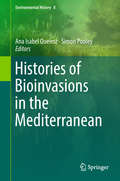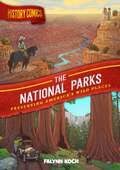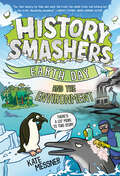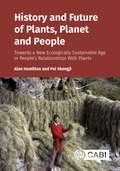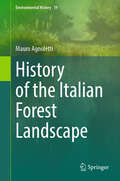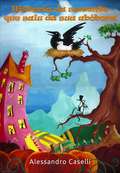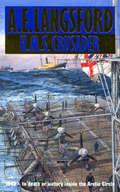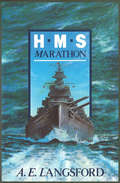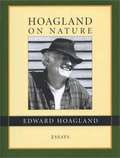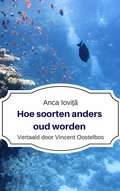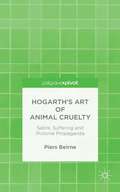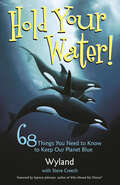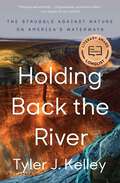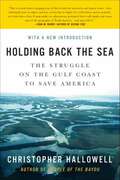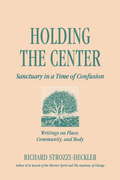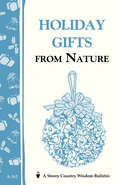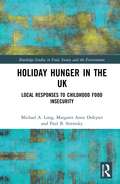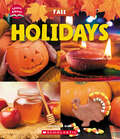- Table View
- List View
Historical Plant Geography: An Introduction (Routledge Library Editions: Ecology #12)
by Philip StottOriginally published in 1981 Historical Plant Geography is an introductory treatment of historical plant geography and stresses the basic theoretical frame of the subject. The book is about neither the study of vegetation nor the concept of the ecosystem, instead focusing on the much older tradition concerned with analysing the geographical distribution of individual species and natural plant groups. Important areas are discussed, such as global plate tectonics and sea-floor spreading, plant maps are introduced and there is a basic treatment of recent advances in plant taxonomy. The book will appeal to students and academics of geography, botany, ecology and environmental sciences.
Historical Pollution
by Stefano Manacorda Francesco CentonzeThis volume examines legal matters regarding the prevention and fighting of historical pollution caused by industrial emissions. "Historical pollution" refers to the long-term or delayed onset effects of environmental crimes such as groundwater or soil pollution. Historical Pollution presents and compares national legal approaches, including the most interesting and effective mechanisms for managing environmental problems in relation with historical pollution. It features interdisciplinary and international comparisons of traditional and alternative justice mechanisms. This book will be of interest to researchers in criminology and criminal justice and related areas, such as politics, law, and economics, those in the public and private sectors dealing with environmental protection, including international institutions, corporations, specialized national agencies, those involved in the criminal justice system, and policymakers.
Historical Urban Landscape
by Gábor SonkolyThis book uses the Historic Urban Landscape - the most recently codified notion of international urban heritage conservation - to demonstrate why it is necessary to demarcate history from cultural heritage and what consequences the increasing popularity of the latter have on history. It also demonstrates how the history of cultural heritage can be constructed as a historical problem. First, the conceptual history of urban heritage preservation - based on the standard setting instruments of international organizations - reveals the fundamental elements of the current concept of urban heritage. Second, this concept, as worded in the HUL approach, is investigated through the analysis of Vienna, which played a crucial role in the establishment of HUL. These examples are used to to show how the evolution of cultural heritage can be constructed as a historical problem.
Historical Variability of Rainfall in the African East Sahel of Sudan: Implications for Development
by John F. HermanceThe northward migration of the African monsoon rains in summer, associated with the seasonal march of the Intertropical Convergence Zone (ITCZ) across the plains south of the Sahara, is the most critical asset for the livelihoods of indigenous peoples and local economies of the Sahel. It is essential that climate science (and its publicly available database) play a key role in characterizing the variabilities of these rainfall patterns in space and time if sustainable life styles are to accommodate the expanding populations of the region. This study turns to the East Sahel of Sudan by analyzing over 100 years of historical rainfall data from three of the few long term standard WMO rain gauge stations in substantially different rainfall settings. From north to south, transecting the Sahel, the stations with their annual rainfall are Khartoum (130 mm); Kassala (280 mm); and Gedaref (600 mm). The conclusions challenge a popular notion that changing climate, drought and desertification in the East Sahel may have already accelerated the deterioration of its water resources. However, any evidence of a persistent and coherent regional trend of diminishing rainfall is obscure. Quite the contrary, the evidence demonstrates that the fluctuations of climate and weather patterns over the ensuing decades of the past century - at all temporal scales from days to years to decades - profoundly overwhelm any suggestion of a large-scale, coherent decrease (or increase) in rainfall. The implication is that, it is not long term change, but the highly localized interseasonal, interannual and multiannual variability of rainfall that poses the greatest and most immediate societal threat from naturally-induced causes; a process constantly destabilizing an agrarian economy struggling to survive in a climate that irregularly vacillates between years of drought and years of flooding. While this report may have some interest for climate scientists, it is primarily directed to a general readership (including students in public policy and anthropology) concerned with the availability of water in the Sahel, particularly the long term sustainability of local small-scale farms and transhumant pastoralism.
Histories of Bioinvasions in the Mediterranean (Environmental History Ser. #8)
by Simon Pooley Ana Isabel QueirozBioinvasions is a current top research subject for natural sciences, social sciences and humanities and a major concern for conservationists, land managers and planners. In the last decades, new findings, perspectives and practices have revealed the multifaceted challenges of preventing new introductions and dealing with those invasive species that harm natural ecosystems, economy and human welfare. This book brings together environmental historians and natural scientists to share their studies and experiences on the human dimensions of biological invasions from the ancient past to the current challenges. The collection of papers focuses on the Mediterranean region and deals with aquatic and terrestrial ecosystems on the mainland and islands, ranging from marine and freshwater environments to coastal marshlands and forests. A wide diversity of animals and plants are featured, from marine fishes to marine and freshwater crustaceans, invertebrates, reptiles and amphibians, birds and mammals, to grasses, shrubs and trees. This book is a contribution to the scientific debate on how to deal with the historical dimensions of biological invasions, fostering dialogue between cultural and ecological explanations of environmental change, to inform environmental policy and management. It has been organized in three sections: the first is the editors’ introduction, in which they review the existing literature and highlight relevant concepts and ideas; the second is about alien species in the Mediterranean region; the third includes cases from other Mediterranean-type regions.
History Comics: Preserving America's Wild Places (History Comics)
by Falynn KochLet this graphic novel be your time machine—experience history like never before! Our past is only the beginning with History Comics.In this volume, The National Parks: Preserving America's Wild Places, turn back the clock to 1872, when Congress established Yellowstone National Park as an area of unspoiled beauty for the "benefit and enjoyment of the people." Meet the visionaries, artists, and lovers of the American wilderness who fought against corruption and self-interest to carve out and protect these spaces for future generations. See for yourself how the idea of National Parks began, how they've changed, and how they continue to define America.
History Smashers: Earth Day and the Environment (History Smashers)
by Kate MessnerMyths! Lies! Recycling scams? Discover the real story behind the first Earth Day celebration and some of the biggest US climate catastrophes--and their solutions! Don't miss the award-winning History Smashers series as they get to the truth on the biggest environmental fibs!In April 1970, twenty million people grabbed their rakes, gloves, and recycling bins to celebrate the first Earth Day. Since that environmental kickoff, nature has never been in better shape. RIGHT?WRONG! The real deal is a bit muddier than that. It&’s true that the first Earth Day encouraged people around the globe to clean up their act when it came to the environment. But activists have been working for centuries to save the planet! Native people across the world developed sustainable farming practices, women in eighteenth-century India stood up to protect trees, and amateur scientist Eunice Foote discovered the science behind global warming all the way back in the 1850s!Join the History Smashers team to bust history's biggest misconceptions and figure out what in the world really went down before (and after!) the first Earth Day—and how you can join the fight to protect the environment.Ready to bust new myths? Check out more titles in the History Smashers series: The Mayflower • Plagues & Pandemics • The Titanic • The Underground Railroad • The Salem Witch Trials
History and Future of Plants, Planet and People: Towards a New Ecologically Sustainable Age in People’s Relationships With Plants
by Professor Alan Hamilton Professor Pei ShengjiThis fascinating book presents the experiences and pooled knowledge of two very different conservation scientists; Pei Shengji from Sichuan, China and Alan Hamilton from London, UK. They have been drawn together over many years through working on some of the same conservation projects and have discovered that they overlap in their ideas about the sorts of work that needs to be done and how it can best be carried out. The book describes some of their own experiences, set within the contexts of their varied careers and the development of their thinking. Plant conservation is crucial to the preservation of natural ecosystems, but conventional approaches have met with only limited success. The authors have concluded that plant conservationists need social allies - elements of society that have other primary concerns, but whose efforts, if successful, will bring benefits to plant conservation too. It is the state and condition of plants on the ground that ultimately matter in conserving ecosystems, and therefore it is the role of local people who interact directly with them which enables success. Ethnobotany is a key skill required of practical plant conservationists. Its techniques enable them to explore connections between people and plants, learn about local perspectives and establish relationships with the people upon whom conservation and sustainable development relies. This book: recommends how to advance plant conservation, based on real experiences. will inspire more people to become involved in plant conservation. demonstrates how the very different backgrounds of the authors have influenced the courses of their careers, but have enabled them to come to very similar conclusions about conservation practice. demonstrates the importance of geographically-based biocultural diversity, as a counterbalancing force to globalisation.
History of the Climate Change on the Coromandel Coast: Ninth–Nineteenth Centuries
by S.Jeyaseela StephenThis book offers a deeper historical context to the interplay between the physical fortunes of climate and weather and the ways in which the Tamil society experienced it in the medieval age. It touches upon the rainfall, famines and droughts, storms and cyclones, earthquakes, floods and tsunamis, temperature and atmospheric pressure of the modern age, noticed by the Catholic and Protestant missionaries, European traders, travellers, the East India Company officials and servants using scientific instruments. Based on a greater variety of Tamil sources, missionary letters and reports, British and French colonial records, the monograph presents the reading of history through the lens of climate and provides a more complete picture of Tamil landscape and environment in South India from the ninth to the nineteenth century.
History of the Italian Forest Landscape (Environmental History #19)
by Mauro AgnolettiThe book explain the history of the italian forest landscape from preroman times to the present. The aim is to demonstrate that all the Italian forest have been shaped by human activities through the centuries and they are an important component of the Italian cultural landscape. The content explores case studies from the north to the south of Italy explaining how human activities shaped extension, density, species composition and structure of the forests in order to meet the need of the society, as well as influencing their ecological features. Timber, fuel wood, charcoal production , as well as shipbuilding, are taken into consideration, but also forest managed for food production( eg. Chestnut forests, wood pastures, pine forests ). Cases such as Venice and the silviculture developed by monasteries are described. The history of the afforestation made by the Italian state in response to climate crisis is also considered as well as case studies related to specific management forms as those related to fires. Management methods such high stand and coppice are explained addressing also the many different traditional practices adopted by the local populations ( selective cutting, pollarding, shredding etc.). The book also shows how forests have doubled their extension since the second world on abandoned farmed land.
História da semente que saiu da sua abóbora
by Alessandro CaselliNut é uma semente que vive, com todas as suas irmãs, uma vida segura e tranquila dentro da "sua" abóbora, mas diferentemente delas está convencida da existência de um "Mundo Lá-Fora". Embora todas a aconselhem, Nut decide superar o medo e sair para ver o que a espera lá fora. Uma formiga, uma cigarra e um pássaro a levarão a descobrir o mundo que elas já conhecem há tempo. Mas que se trate mais uma vez de uma outra abóbora da qual se tem de tentar sair?
Hms Crusader
by A E LangsfordDeath by fire - Death by ice. These were the twin threats confronting the seamen on the North Atlantic convoys: fire from the Luftwaffe's bombs, and from the torpedoes of the lurking U-Boats: ice in the deadly cold waters that could kill in three minutes, five minutes at most.Between these two hells lived another threat: the slow paralyzing hand of fear.
Hms Inflexible: The war in the Pacific is reaching its climax…
by A E Langsford1945. The battle against Japan in the Pacific is reaching its climax. One way or another, Inflexible will be Captain Thurston's last command of the war.Captain Thurston VC is a navy man to his bones. Offered a cushy office job to see out the last months of the war, he resists: instead he's handed command of HMS Inflexible, a proud and powerful aircraft carrier.It is no easy task. The overwhelming determination of the Japanese fighters and the cruel weather conditions make Thurston's command fraught with difficulties, but the struggle to provide air support for the US and Commonwealth troops must continue.Home is on the other side of the world, barely a reality, and Thurston finds that he is striving to do the right thing, not only as the Captain of the Inflexible but also in his private life. For a while he and his men are under daily attack from a deadly enemy, Thurston is plagued by feelings of guilt and remorse for the woman he has left behind.A. E. Langford's compelling naval adventure is an evocative account of life at sea during one of the most perilous and hard-fought battles of this century.
Hms Marathon
by A E Langsford1942: The Mediterranean. The war at sea is at its most intense. Operation Stonehenge gets under way - a convoy laden with desperately needed fuel, food and ammunition for the besieged island of Malta sets sail. Captain Robert Thurston commands the cruiser HMS Marathon, one of the escort vessels on this Malta run. Thurston is a career officer with a record of conspicuous gallantry under fire, from Jutland to the North Atlantic convoys. But he is also a man under stress - in the last three years he has seen one ship go to the bottom, leaving pitifully few survivors; he has seen his closest friends and shipmates killed and maimed; he has carried the impossibly heavy burden of responsibility for his men's welfare in the bloody destruction of war at sea.And soon another cause for concern is added to his worries - Marathon is crippled by enemy action and forced to limp towards Alexandria, a constant target for attack by sea and air, vulnerable to the weather and to the enemy alike. Men and machines are stretched to their limit - but the most deadly threat to Thurston's own life and career is yet to be faced.
Hoagland on Nature
by Edward Coolbaugh HoaglandHoagland discusses a range of subjects from the natural history of owls to the delicious mystery of wolves in stories such as "Howling Back at the Wolves"; the demise of the red wolf "Lament the Red Wolves"; our relationship with dogs "Dogs, and the Tug of Life"; the nature of a bear-stalker "Bears, Bears, Bears"; and the intricate workings of an old farm's ecosystem. Hoagland reports from the front lines of life. He recounts fascinating detail with exacting prose. He's irascible, brilliant, probing, sharp-witted, and brutally honest about himself and the state of the natural world. No one who admires John Muir, Henry David Thoreau, John Burroughs, and Edward Abbey should miss this definitive collection. It will forever change the way you view the natural world.
Hochwasserminderung im ländlichen Raum: Ein Handbuch zur quantitativen Planung
by Simon P. Seibert Karl AuerswaldDiese Open-Access-Publikation ist ein anwendungsorientiertes Lehr- und Handbuch zur Abflussminderung im ländlichen Raum. Meteorologische Extreme wie Dürren, Starkregen und Überschwemmungen häufen sich wegen des Klimawandels. Gleichzeitig steigt der Druck auf unsere Landschaft kontinuierlich, indem sie immer intensiver genutzt und effizienter erschlossen wird. Durch diese Entwicklungen ergeben sich dringende Herausforderungen für den ländlichen Hochwasserschutz und den Erhalt unserer natürlichen Ressourcen Wasser und Boden.Das Buch beschreibt Methoden für die Planung von Maßnahmen zur Abflussminderung. Es ist speziell für kleine Einzugsgebiete ( Die Autoren:Dr. Simon P. Seibert ist Ingenieurökologe und hat über die Entstehung und Modellierung von Hochwasser in München und Karlsruhe promoviert. Seit Mitte 2019 leitet er der Arbeitsgruppe Gebietshydrologie am Bayerischen Landesamt für Umwelt.Prof. Dr. Karl Auerswald lehrt am Wissenschaftszentrum Weihenstephan für Ernährung, Landnutzung und Umwelt der TU München. Seine Forschungsschwerpunkte der vergangenen 40 Jahre sind agrarökologische Prozesse, insbesondere der Wasserhaushalt von Landschaften, Böden, Pflanzen und Tieren.
Hoe soorten anders oud worden
by Anca IovițăVeroudering is een puzzel die opgelost kan worden. Het proces van veroudering wordt van oudsher bestudeerd in enkele biologische modelorganismen zoals fruitvliegjes, wormen en muizen. Wat al deze soorten gemeen hebben is hun korte levensduur. Voor een laboratoriumstudie op een budget is dit ideaal. Het is een goede strategie voor de korte termijn. Wie heeft er nou tijd om soorten te bestuderen die decennia leven? Maar verschillen in levensduur tussen soorten zijn vele malen groter dan de variatie in levensduur die in het lab kan worden aangetoond. Daarom heb ik talloze informatiebronnen bestudeerd in een poging veel uiterst specialistisch onderzoek samen te brengen in één goed leesbaar boek. Ik wilde door de bomen het bos weer kunnen zien. Ik wilde in enkele duidelijke en logische stappen openbaren hoe soorten anders oud worden. Dit boek is mijn poging om dat te doen. Welke mechanismen staan aan de basis van deze ongelijkheid in veroudering tussen soorten? Hoe worden soorten anders oud? Ik heb er opzettelijk voor gekozen het antwoord op deze vraag in eenvoudige taal te formuleren. Onderzoek naar veroudering is te belangrijk om te verhullen met formeel wetenschappelijk jargon. Dit boek zou niet hebben bestaan zonder de uitvinding van groene thee, bibliotheken en het internet. De hoeveelheid data die ik heb doorgespit om de essentiële patronen te achterhalen is immens. Toch is dit boek niet uitputtend. Het is geen droog academisch handboek. Ik heb geprobeerd een onderwerp levendig te maken dat ontzettend belangrijk is voor het verlengen van het menselijke leven. Jij alleen kunt bepalen of ik hierin geslaagd ben. ********** Inhoudsopgave ********** Door de bomen het bos terugvinden Betrouwbaar is goed De wiskunde van de veroudering De snelheid van senescentie Case: veroudering bij vissen Hoe schat je chronologische leeftijd Rustig aan Tem
Hogarth’s Art of Animal Cruelty: Satire, Suffering and Pictorial Propaganda
by Piers BeirneWilliam Hogarth, one of England's foremost artists, made extensive use of animal images - as hybrids, edibles, companions, emblems of satire and objects of cruelty. Hogarth's Art of Animal Cruelty: Satire, Suffering and Pictorial Propaganda offers an important examination of Hogarth's intentions in the Four Stages of Cruelty (1751), a series of four prints generally neglected by art historians and wrongly identified by legal historians and other scholars as a milestone in the development of animal rights. In this book, Beirne analyses how Hogarth's various audiences would have reacted to his gruesome images, and ultimately what was meant by 'cruelty'.
Hold Your Water: 68 Things You Need to Know to Keep Our Planet Blue
by Wyland Steve CreechHold Your Water offers insight into the water and world around us. Taking a conversational approach to conservation, it dives into simple ways that even little old you can make a difference--all with a witty, and at times whimsical, slant on the world in which we live. The Wyland Foundation is widely lauded by politicians and scientists alike for its practical insight and positive impact on our planet. Former Vice President Al Gore praised the group, saying, "Your organization makes an invaluable contribution to the effort to promote environmental awareness."Hold Your Water is the latest in the organization's legacy of arming everyday people with straight-ahead insight and simple tips for keeping our planet blue. Written by two members of Wyland's staff, the book provides countless fascinating facts about our planet. For instance, did you realize that while two-thirds of the earth's surface is covered by water, only 3 percent of that water is safe to drink? And of that 3 percent, nearly two-thirds is locked up in polar ice caps?The book offers easy ways for people to help preserve water and other related precious resources. Divided into more than 30 sections, this compendium illustrates how everyday activities such as car washing, showering, fertilizing--even 'pet poop' cleanup--can negatively impact the environment. It then delivers more than 100 tips and tidbits that will help you protect your planet.Whether you are one of the nearly three-quarters of Americans who consider themselves environmentalists, or you just want to know more about the world in which you live, Hold Your Water is a book worth holding on to.
Holding Back the River: The Struggle Against Nature on America's Waterways
by Tyler J. KelleyA revelatory work of reporting on the men and women wrestling to harness and preserve America&’s most vital natural resource: our rivers.The Mississippi. The Missouri. The Ohio. America&’s great rivers are the very lifeblood of our country. We need them for nourishing crops, for cheap bulk transportation, for hydroelectric power, for fresh drinking water. Rivers are also part of our mythology, our collective soul; they are Mark Twain, Led Zeppelin, and the Delta Blues. But as infrastructure across the nation fails and climate change pushes rivers and seas to new heights, we&’ve arrived at a critical moment in our battle to tame these often-destructive forces of nature. Tyler J. Kelley spent two years traveling the heartland, getting to know the men and women whose lives and livelihoods rely on these tenuously tamed streams. The result, Holding Back the River, is a deeply human exploration of how our centuries-long dream of conquering and shaping this vast network of waterways squares with the reality of an indomitable natural world. On the Illinois-Kentucky border, we encounter Luther Helland, master of the most important—and most decrepit—lock and dam in American. This old dam, at the tail end of the Ohio River, was scheduled to be replaced in 1998, but twenty years and $3 billion later, its replacement still isn&’t finished. As the old dam crumbles and commerce grinds to a halt, Helland and his team must risk their lives, using steam-powered equipment and sheer brawn, to raise and lower the dam as often as ten times a year. In Southeast Missouri, we meet Twan Robinson, who lives in the historically Black village of Pinhook. As a super-flood rises on the Mississippi, she learns from her sister that the US Army Corps of Engineers is going to blow up the levee that stands between her home and the river. With barely enough notice to evacuate her elderly mother and pack up a few of her own belongings, Robinson escapes to safety only to begin a nightmarish years-long battle to rebuild her lost community. Atop a floodgate in central Louisiana, we&’re beside Major General Richard Kaiser, the man responsible for keeping North America&’s greatest river under control. Kaiser stands above the spot where the Mississippi River wants to change course, abandoning Baton Rouge and New Orleans, and following the Atchafalaya River to the sea. The daily flow of water from one river to the other is carefully regulated, but something else is happening that may be out of Kaiser and the Corps&’ control. America&’s infrastructure is old and underfunded. While our economy, society, and climate have changed, our levees, locks, and dams have not. Yet to fix what&’s wrong will require more than money. It will require an act of imagination. Meticulously researched and as lively as it is informative, Holding Back the River brings us into the lives of the Americans who grapple with our mighty rivers and, through their stories, suggests solutions to some of the century&’s greatest challenges.
Holding Back the Sea: The Struggle on the Gulf Coast to Save America
by Christopher HallowellKatrina's arrival on the Gulf Coast was a long time in coming. But it was assured. Since 1965, when Hurricane Betsy struck New Orleans, breached a levee, and flooded part of the city, everyone was waiting and talking about when the Big One would strike and do even more damage. Katrina was that hurricane, predictedand imagined before she struck, but so much worse in her reality.Holding Back the Sea is about the consequences of ignoring the warning signs that nature provides and the struggle to convince the rest of the country that South Louisiana lay in the path of destruction. The signs were not subtle; there were Hurricanes Andrew in 1992, George and Mitch in 1998, and Ivan in 2004, among others. At one time or another in their journeys north, they all threatened New Orleans. Some had headed right for the city before veering to the east and west, sparing the Big Easy and reinforcing the nickname. But the Big Easy ended -- at least in reputation -- on August 29, 2005, when the Big One came ashore as Katrina.
Holding the Center: Sanctuary in a Time of Confusion
by Richard Strozzi-HecklerAs in all his books, Heckler draws from personal experience: training his horse, cultivating presence in aikido dojos, consulting with business executives, raising children. A masterful and encompassing book,Holding the Centerdevelops from the fulcrum of the self in the natural world. Many of Heckler's lessons arise from his life as a householder and father. Community is a larger family--we make alliances to "take care of what matters to us. " But, as Heckler teaches, that takes listening to others with an open heart, and learning what the needs of others are. The world can be a sanctuary, if we find a balance between instinct and choice. Richard Strozzi Heckler sounds an important call about the interplay between power and generosity in these subtle and luminous essays. From the Trade Paperback edition.
Holiday Gifts from Nature: Storey's Country Wisdom Bulletin A-162
by Cornelia M. ParkinsonSince 1973, Storey's Country Wisdom Bulletins have offered practical, hands-on instructions designed to help readers master dozens of country living skills quickly and easily. There are now more than 170 titles in this series, and their remarkable popularity reflects the common desire of country and city dwellers alike to cultivate personal independence in everyday life.
Holiday Hunger in the UK: Local Responses to Childhood Food Insecurity (Routledge Studies in Food, Society and the Environment)
by Paul B. Stretesky Michael A. Long Margaret Anne DefeyterThis timely and much-needed book focuses on the phenomenon often referred to as "holiday hunger" in the United Kingdom. The book begins by outlining the history and scope of holiday hunger – the condition that occurs when a child’s household is, or will become, food insecure during the summer holidays. The decline of the UK welfare state and the rise of neoliberalism have created a situation where up to three million children in the UK face food insecurity during the summer months when there are extra financial pressures on the working poor and when free school meals are not available. This book details the level of childhood and household food insecurity in the UK and describes one of the main responses to holiday hunger – holiday clubs. These clubs are locally organised and funded and provide a place for children to go to eat nutritious meals for free during the school holidays. Highlighting the benefits of holiday clubs that often extend beyond food provision, this book also discusses the challenges that they face now and in the future. The book concludes with recommendations for food insecurity policy and the role of government in fighting holiday hunger. This book will be of great interest to students and scholars of food and nutrition security, social policy and public health.
Holidays (Learn About)
by Sonia W. BlackLet's learn all about the most important symbols and celebrations of the fall season!Some of our most cherished holidays happen in fall. With vibrant photos and lively text, this book explores the many reasons we have to celebrate while leaves change color and fall off the trees. Get ready to learn all about different holidays in fall!ABOUT THE SERIES: Fall is here and so are colorful leaves, delicious apples, orange pumpkins, and lots of celebrations! With this new series, dive into the icons that make fall so much fun. Why do we harvest apples in fall? How does a pumpkin grow? Why do leaves change color? What holidays are in fall? With gorgeous photographs and simple text, this is a celebratory exploration of the fall season.

